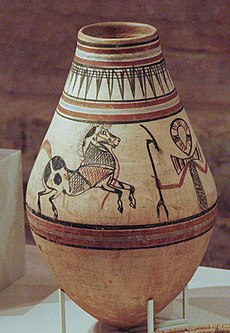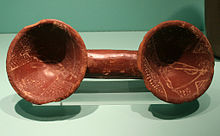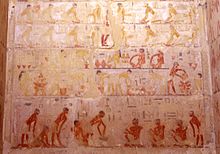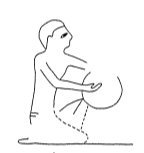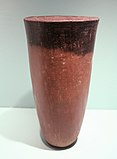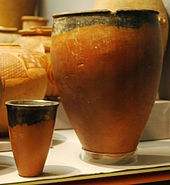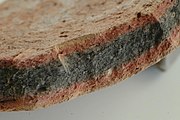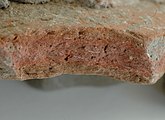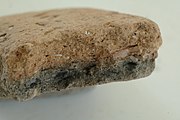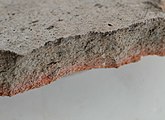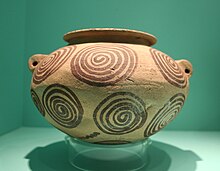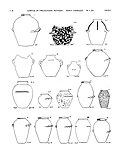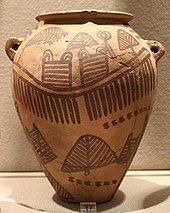Pottery in ancient Egypt
| Ceramic in hieroglyphics | |||||
|---|---|---|---|---|---|
qerhet qrḥt pottery |
|||||
| Vessel depicting a galloping horse from the 18th dynasty ( white-background style) | |||||
Under ceramics in ancient Egypt it includes all objects made of fired clay from ancient Egypt together (by Dorothea Arnold figurative except objects). The ceramic vessels were mainly used as household goods and were associated with the storage, preparation, transport and consumption of food and raw materials . These include beer and wine mugs , water containers, but also the bread baking molds, fire basins, lamps and stands that are often used in the household, on which round-bottomed containers could be placed. Other types served ritual purposes. Often ceramics were found as grave goods .
In Egyptian archeology, a distinction is made between two groups of clays according to chemical and mineralogical composition and ceramic properties: Nile clays and marl clays . The Nile clay is a weathering product that the Nile transported from the Ethiopian mountains to Egypt. The clay was deposited on the banks between the Young Pleistocene and the present time when the Nile was flooded . Marl clay is a yellowish-white rock that is embedded in limestone deposits. The layers of deposits were formed in the Pleistocene , when primeval water masses from the Nile and its tributaries washed this clay down to the current edge of the desert.
The Egyptian representations on grave walls, pottery models and archaeological remains of pottery workshops provide information about the production and organization of ceramic production. It is characteristic of the history of the development of ceramics that in the course of time newly invented methods never completely replaced the old ones, but expanded the repertoire, so that at the climax of the history of ceramics each group of objects is assigned the appropriate assembly technique. The Egyptian potters used a wide range of decoration techniques and motifs, some of which were characteristic of certain periods, including the creation of unusual shapes, incised decorations and various burning methods and painting techniques.
An important classification system for classifying Egyptian ceramics is the so-called Viennese system in Egyptology, which the archaeologists and Egyptologists Dorothea Arnold, Manfred Bietak , Janine Bourriau , Helen and Jean Jacquet and Hans-Åke Nordström developed at a meeting in Vienna in 1980 .
In the archaeological and relative chronology , the method of the ceramic has Seriation been useful. This method was introduced by WM Flinders Petrie in 1899 . It is based on changes in the blood vessels and the appearance and disappearance of various types over time.
Materials
To understand the development, type and origin of ceramics, it is necessary to understand the material clay . In Egyptian archeology, a distinction is made between two groups of clays according to chemical and mineralogical composition and ceramic properties: Nile clays and marl clays . A mixture of the two groups can be added as a further group.
Nilton
The Nile clay is a weathering product that the Nile transported from the Ethiopian mountains to Egypt. The clay was deposited on the banks between the Young Pleistocene and the present time when the Nile was flooded . As a result, deposits can occur far away from the current course of the river as well as within today's river plains. The clay is chemically characterized by a high silicon content and high proportions of iron oxides . From a mineralogical point of view, these are sediment clays rich in mica and illite , to which sand and various rock particles from the extensive catchment area of the Nile are already mixed (and do not have to be added by human hands). The clay turns red to brown when fired in an oxidizing furnace atmosphere . In the raw state it varies from gray to almost black.
Marl clay
The marl clay (also desert clay) appears along the Nile valley between Esna and Cairo , in the oases and on the edges of the delta . It is a yellowish-white rock that is embedded in limestone deposits. The layers of deposits were formed in the Pleistocene , when primeval water masses from the Nile and its tributaries washed this clay down to the current edge of the desert. Marl clay denotes a series of clay types that are already very different in their basic substance. What they have in common is a lower proportion of silicon and a significantly higher content of calcium (hence the name marl = clay and lime). The most important types of marl clay are:
- Qena clay: secondary deposits such as those from Wadi Qena . Such clays come from sediments that washed down from the wadi and mixed with local shale and limestone.
- Marl clays made from slate and limestone found along the Nile between Esna and Cairo.
Marl clays usually turn creamy white or white when fired in an oxidizing atmosphere. In addition, the cut can have pink or orange zones. These clays are rich in mineral salts , so the surface is often covered with a thin layer of weathered salts that, when burnt, form a white surface that, if neglected, can be mistaken for a "coating". At a sufficient firing temperature (approx. 1000 ° C) this coating turns olive green and resembles a green glaze.
Quaternary clay in Estonia
Manufacturing
Choice of material
The choice of material was determined by local conditions and the function of the object to be manufactured. The nile clay was mainly used for household dishes and forms and containers of handicrafts such as pottery for ritual use. Marl clays were predominant in storage and where refined products (figure vessels and the like) were made.
Breakdown of the sound
There is little precise information about how and where the ancient Egyptian potters mined the raw material, such as ownership of the pits, organization of transport and allocation to the potters. In general, one can say that the clay could have come from three different areas: from the banks of the Nile or an irrigation canal, from the desert plain next to the cultivation areas or from the hills of the higher desert. A representation in the grave of Rechmire ( TT100 ) shows workers digging a pile of Nile mud with hoes for the production of mud bricks . Clay for pottery making could have been quarried in the same way. The scene also shows that Nilton didn't necessarily have to be won by a field. Nile clay piles were accumulated while digging a canal, as they do today.
Extraction of Nile mud for mud brick production .
Preparing the clay

With the preparation of the clay, the Egyptian representations on grave walls usually began. There are also models that sometimes reproduce details a little differently. Clear archaeological remains of pottery workshops, on the other hand, are rather rare. Presumably these were extremely ephemeral investments.
Clay exposed to air dries very quickly. That is why the potters often received the clay (especially the marl clay from the desert) as dry, stony lumps that first had to be crushed and mixed with water to make them malleable. The raw clay was also dried and pulverized to remove larger contaminants such as pebbles by sieving. Another possibility was the slurrying of the clay by repeatedly letting the heavy clay components sit in the water and skimming the fine parts above. There is no evidence of such a process in the pottery workshop and ceramics in Ayn Asil ( Dachla ), but possible evidence of it in Hierakonpolis . The slurry had to be carried out in one or more pits or water basins. The pottery depiction in the grave of Kenamun ( TT93 ) has already been interpreted to mean that it also shows a basin for slurrying. At least for the clay of the Meidum bowls in the Old Kingdom and the strikingly homogeneous Nile clay since the beginning of the 18th dynasty, a refined cleaning technique can be assumed.
The picture shows one or two men for the preparation of the clay, who trample the softened clay mass mixed with water in order to transform it into a plastic, malleable mass. In this processing step, the clay could be leaned if it did not already have finer impurities such as sand and other materials. It was important that these were not too coarse or too sharp-edged: “Too coarse leaning can make the vessel wall unstable if the plastic clay minerals cannot interlock. Sharp-edged particles such as pebbles can injure the potter when kneading and shaping the vessels and prevent a flat surface from being created. "The addition of balanced leanness made the clay" more plastic, easier to shape and more stable in the vessel structure, and also more porous and air-permeable, which the Properties during drying, firing and use of the finished vessel improved ”.
After mixing with water, the clay mass is full of air bubbles. In order to prevent the formation of cracks during the firing process, these had to be removed during the so-called milling process. Two halves of a clay mass were hit against each other with relatively great force. In the picture, a worker in a bent posture kneaded the clay with his hands before he passed the milled bales directly to the potter.
Methods of shaping
Five different construction techniques can be distinguished for the ceramic production of ancient Egypt:
- by hand
- using a rotating pedestal
- with a potter's wheel operated by the hand of the potter ("slowly rotating disk")
- with the help of models
- on the fast turning potter's wheel driven by an assistant or the potter's foot
It is characteristic of the history of the development of ceramics that in the course of time newly invented methods never completely replaced the old ones, but expanded the repertoire, "so that at the climax of the history of ceramics each group of objects is assigned the appropriate assembly technique".
Assembly by hand

For the construction by hand, different techniques can be distinguished: piling up several clay sausages on a base plate, rags and free modeling. These three manufacturing methods were used from prehistory to the Old Kingdom or even longer.
Free modeling by kneading and pulling by hand is the oldest and at the same time most durable technique of shaping. It was used in the Fayum-A culture and the Merimde culture for all vessels and probably also in the Badari culture , in the Old Kingdom for certain types and at all times for round sculptural figures and models. The goods are thick-walled. The technique can be recognized by the pressure and pressure marks that were created by joining the lumps of clay.
With the rag, rectangular clay plates are joined together ( plate technique ). The technology can be recognized, among other things, by the fact that the vessels mostly disintegrate into rectangular shards . It is likely to have been used on a large scale in early Egypt, at least since larger clay vessels were formed. Throughout the Pharaonic era up to the Romans, large vats were made using this technique.
When building with clay sausages, the next one was placed on a dried-on bead. This technique could be observed in the late prehistoric ceramics of Heliopolis.
Construction on a rotating base
A rotating base for the technique of vessel construction has been used since the Chalcolithic period . This perhaps arose from the need “to give the vessel to be shaped an even curve of the body and especially the opening”. The technology can be clearly recognized by the horizontal traces of rotation in the opening. In contrast to the potter's wheel, the rotary movements are not centered due to the lack of a fixed axis.
Bowls, plates, baskets and mats, textiles and even ceramic shards that rotate together with the vessel in the structure can be used for the rotating base. The potter only made decisive use of the advantage of the rotary movement when manufacturing the upper part of the vessel. The already known techniques were now used in combination. Closed vessels in particular show signs of pressure from the free hand construction in the lower area, but the edge was turned after the entire vessel was completed.
Set up on a manually operated, slow turntable
An important invention was the axis-centered potter's wheel . This enabled the potter to turn the base and the vessel with one hand and to shape the vessel with the other hand.
According to Dorothea Arnold , the slow turntable was invented during the 4th dynasty. According to E. Christiana Köhler , however, the dating approach should be corrected to a much earlier point in time: “The innovation of the potter's wheel is a development that generally goes hand in hand with a certain form of mass production. It enables serial turning and a quick sequence of finished vessels. ”This development can be clearly traced in the mass-produced conical bowls of the Mesopotamian Uruk culture in Habuba Kabira .
To make it, a large clay cone was first piled on the disc. The point of the cone was the actual pivot point from which the bowls were raised. Then you cut them off from the cone with a wire or string. This resulted in bowls with relatively thick walls near the bottom and twisting or peeling marks on the underside of the bottom. Christiana Köhler was able to identify such traces of removal on vessels from the early days , which makes production on the slow turntable likely already at this time.
Construction of ceramics with a turntable in Indonesia (around 1930)
Construction with the help of models
It can be assumed that the baking molds for cone bread in particular were shaped with the aid of a model core. Presumably they were formed around a conical (wooden) core, which had the shape of the cone bread to be baked.
Construction on the rapidly rotating potter's wheel
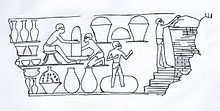
The structure on the fast rotating potter's wheel, driven by an assistant or the potter's foot, was developed relatively late, at the earliest in the New Kingdom. For the first time, a depiction in the tomb of Kenamun from the middle of the 18th dynasty shows a deep turntable where an assistant grabs the turntable and thus helps the potter to operate the turntable while the potter himself uses his foot to help to stabilize the disc.
Surface treatment
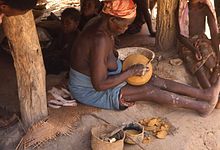
The formed vessel first had to dry out in order to give the wall sufficient stability for further processing. In a so-called leather-hard state, there was still enough moisture in the clay to make plastic changes. At this stage (if desired) the painting and the application of the coating and slip took place . After further drying, the vessels may have been polished over. There are two different techniques for polishing the surface of the vessel:
- The polishing by rubbing without the use of significant pressure creates an even, slightly matt gloss. Examples of this are the jugs of the Old Kingdom, jugs and bowls from the First Intermediate Period and perhaps the Middle Kingdom as well .
- In contrast, when polishing with a pebble (English burnish ) or some other hard object, considerable pressure is exerted on the surface of the vessel. The result is a high-gloss surface, but only in rare cases of particularly careful work do not polish stripes remain visible (for example on the Meidum bowls of the Old Kingdom). In the Thinite period and the 17th and 18th dynasties, potters made use of the visibility of the polish strips to create their own form of decoration.
At this stage it was also possible to apply imprint and incised decorations, "because the clay was still moist enough not to crack during this process, and was already sufficiently dried so that no warping occurred when scratching". These were, depending on the pattern with different instruments such as bone or wood needles, combs made of bone or shells or flint attached -Messern.
After an initial drying phase, the round floor was also finished. This was done by hand before the 17th dynasty by cutting and spreading it with a flat instrument. Base ring feet were also hand-cut or freely modeled and attached from added clay. After the beginning of the 17th dynasty, however, standing ring feet were turned on the potter's wheel from the clay already present on the bottom of the vessel. Round floors and stand areas are now increasingly showing signs of rotation on the outside.
Drying
During the drying process, the vessels had to be set up under well-controlled conditions so that all parts dry and shrink evenly and thus do not deform. During this process, as much water as possible had to evaporate because the remaining, chemically bound water begins to boil and evaporate at the beginning of the firing process and when the boiling point is reached: “This leads to an expansion in volume of the water vapor, which leads to flaking and breakage when it cannot escape. "
Depending on the weather and solar radiation, the vessels were placed to dry in the sun (with little solar radiation) or in the shade (with high solar radiation) or in closed rooms (with rain and cold). The drying process could take several days and depended, among other things, on the weather conditions, but also on the size, wall thickness and porosity of the vessels. Even after it had apparently completely dried out, there was still around three to five percent residual moisture that was only lost during the fire.
fire
The fire process changes the state from a plastic to an aplastic material. Up to this point it is possible to add water to a vessel and turn it back into plastic clay and thus recycle it. After the fire, heavily damaged vessels such as false fires are almost unusable.
In order for the so-called ceramic transformation to take place (i.e. the transformation of the clay into a final and liquid-resistant form), a temperature of 550–600 ° C must be reached. Before this, the residual moisture remaining during drying is released into the air at around 100 ° C and the chemically bound water ( crystal water ) escapes when it is further heated to 300 ° C. Important during the fire is the supply of oxygen , which is consumed ( reduced ) when the fuel is burned : “If it is not supplied further, ie through openings, nozzles or flaps, a combustion atmosphere enriched with carbon monoxide or free carbon develops , and black to black-brown iron (II) oxide is produced , which gives the fired ceramic a gray to brown-black color. ”This is a reducing firing. In the oxidizing burning process ( oxidation ), on the other hand, oxygen is supplied during the fire. The iron minerals in the clay absorb oxygen and turn red. Red to reddish brown iron (III) oxide is formed . This pottery is red-brown in color.
The simplest and earliest combustion process is open fire. The vessels to be burned were heaped and filled with fuel. They were placed on the flat ground, surrounded by a small wall, or placed in a pit. During the burning process, there was relatively little control over the burning process. The material to be fired had direct contact with the flames and the fuel, which heats up quickly and cools down again quickly.
The combustion result was optimized by installing nozzles, walling up the combustion chamber with heat-storing walls and separating the material and fuel. This technological stage was reached in the earlier Old Kingdom at the latest, if not in the early days or in late prehistory.
The simplest construction of a pottery furnace was a shaft furnace with no separation of combustion chamber and combustion chamber. It could be loaded from above through the shaft opening and an opening on the floor could be fired. This opening enabled the supply of oxygen if required, which could lead to an oxidizing firing atmosphere. The furnace first had to reach a certain firing temperature in order to heat the material in the firing chamber. This made the fire longer and more even.
The next technological advance was the introduction of a perforated barn that separates the combustion chamber from the combustion chamber. This prevents smoky flames and carbonized fuel from coming into contact with the ceramic and causing stains and stains. The vessels to be burned were stacked in the upper part, with the opening facing down. The hot gases rose past the vessels and circulated within them, and thereby the clay was burned. Such shaft ovens with a perforated tennis court have been documented by pictorial representations and archaeological finds since the Old Kingdom.
decoration
The Egyptian potters used a wide variety of decorative techniques and motifs, some of which were characteristic of certain periods. There were three ways to apply them during the machining process: before, during or after firing.
Since the predynastic period, potters have played with design by creatively designing the pottery or by imitating other materials such as wickerwork, metal, wood or stone. Most of the fancy features were added during build and surface finishing, long before firing. The elements were either formed by hand from a piece of clay or pressed into molds and pressed against the vessel in a leather-hard state, which in many cases is shown by fingerprints on the inside of the vessel. In the case of figural vessels, these were often parts of the human or animal body or the face of the god Bes or the goddess Hathor . It was also widespread that parts of the vessel were cut out in a leather-hard state in order to imitate non-ceramic materials.
Even in the earliest Egyptian ceramics, an early phase of the Merimde culture , incised decorations such as herringbone patterns were found . In this technique, large amounts of clay were removed from the leather-hard surface with a sharp-edged instrument such as a stick, knife, needles or fingernails.
Since the potters in the 5th century BC BC knew only simple fire methods in a furnace, these vessels often had a black upper rim. These black borders increasingly became a decorative element, which required a certain technical knowledge. In combination with a dark red color and a pollitur, the black-topped goods became one of the most accomplished and popular goods. The black color was achieved through carbonization (charring), for example through the infiltration of smoke particles into the clay mass. However, some questions about this manufacturing technique have not yet been clarified.
Painted decorations were applied with a brush before or after firing. For special patterns, paint was also sprayed onto the surface or the vessels were dipped into the paint. There were eight main styles of painted decoration in ancient Egypt:
- Petries white-cross-lined style: This pottery was only found in Upper Egypt for the Naqada culture of stage I (approx. 4000–3500 BC). It usually consists of nile clay (Nile clay A). The surface ranges from dark red to reddish brown and has a polish. A characteristic feature is the white to cream-colored painting (predominantly geometric patterns, but also animals, plants, people and boats).
- Petries decorated style: This ceramic is typical of the Naqada culture of stages II and III (approx. 3500–3000 BC). It mostly consists of marl clay (marl clay A1). The surface is well smoothed but not polished. The color ranges from light red to yellowish gray. A painting was applied to the surface with red-brown paint. Main motifs are ships, desert game, flamingos, people, spirals, wavy lines and Z-lines.
- The white-background style: This style occurred in the First Intermediate Period , the Early Middle Kingdom, the New Kingdom, and the Late Period. The goods of this style were decorated in different colors on a white background after firing. The decoration usually includes carefully crafted sacrificial scenes.
- The scenic style: This style has appeared sporadically at all times. It is closely related to the white-background style, except that the scenes were painted directly (with no white background) on the surface of the vessel.
- The blue-painted style: This style occurred from the middle of the 18th Dynasty to the end of the 20th Dynasty. Above all, blue color pigments were used, plus black, red and, more rarely, yellow. It was mainly about floral decorative elements : lotus flowers and buds as well as individual petals of different flowers were painted on in such a way that the impression arises as if they were tied to threads around the neck and shoulders of the vessels. There were also depictions of young animals and emblems of the gods Hathor and Bes. The pottery was mainly made of nile clay.
- The brown-and-red painted style: This style emerged at the beginning of the 18th Dynasty from the decorative custom of simple lines in the late Middle Kingdom and the 2nd Intermediate Period. In contrast to the blue-painted style, this ceramic consisted mainly of marl clay. The style consisted of very specific decorative patterns: these contained a group of two to four parallel lines, between which various elements such as points, zigzag lines, wavy lines and others were painted. The elements were also differentiated by different colors: either brown elements and red lines or vice versa.
- The lotus-flower-and-crosslined-band style:
Bes vessel
Objects and function

In Egyptology, the term ceramics covers all non-figurative objects made of fired clay. The majority of ceramic vessels were certainly used as household goods and were related to the storage, preparation, transportation and consumption of food and other raw materials. This also includes the bread baking molds, fire pans, lamps and stands often used in the household, on which round-bottomed vessels could be placed. Other types served ritual purposes. In some cases, water pipes were constructed from nested amphorae; actual ceramic pipes only existed since Roman times. Musical instruments such as rattles were also made from clay vessels by filling bottles with pebbles and closing the openings before the fire.
Indications of the function of a vessel are given by representations in graves, inscriptions, the form, the design, remains of the contents and the archaeological find context. In the graves, the vessels are often only drawn schematically. Nevertheless, in a few cases the function of the vessels could be identified on the basis of the grave representations. These include bread molds, spinning bowls and beer mugs. The shapes of the beer mugs can be determined by means of the relief representations (for example in the mastaba of the Ti) with scenes of beer production: ovoid , round-bottom bottles with often weakly pronounced lip, which are usually roughly shaped and made of a clay that is heavily leaned with organic components.
Inscriptions indicating the contents of the vessels are not unusual in the New Kingdom. This allows wine jugs and meat vessels to be identified, even if wine jugs have been used for other raw materials such as oil and honey. One of the largest finds of labeled wine vessels comes from the tomb of Tutankhamun ( KV62 ). The inscriptions on the 26 labeled wine jugs provide better information about the wine they contain than most modern bottle labels. The year of harvest was given with the year of the reign of the king. The quality, the origin of the grapes, the owner of the vineyard and the head winemaker who was responsible for the product were also noted. (See also Wine in Ancient Egypt .)
The vessels themselves also give advice on how to use them, such as the type of clay, surface treatment and shape. In certain circumstances, porosity (permeability) is desirable or not. So let modern storage vessels for water as ZIRS and Gulla the water seep through the walls, so as to cool the content through evaporation ( "evaporative cooling"). This effect can be optimized by manufacturing from a light tone or with a light coating. That is why Christiana Köhler interpreted bulbous bottles or jugs, which were made from the standard base material with a white coating or from a light, coarse-grained marl clay, partly as water containers when processing the early ceramics from Buto . The opposite effect can be achieved by a dense coating. This fills the pores of the surface and the walls of the vessel become impermeable to liquids. A polished surface also fulfills this purpose. This also makes a vessel easier to care for and more hygienic, as no (food) residues stick. This can be useful for drinking and food bowls and plates.
Early Abydos wine jugs
Social context of production
The determination of the ceramic industry in the broader social and economic context of ancient Egyptian society has so far only been treated superficially in ceramic research.
Grave decorations and pottery models give only a few clues as to the context in which the manufacture took place. The depictions from the Old Kingdom are closely related to brewery and bakery scenes, which were also depicted independently of the ceramic production. This suggests that ceramic production was a natural part of food production. In addition, the grave owners needed food and drink in the afterlife and not the empty vessels.
Models of pottery workshops from the First Intermediate Period and the Middle Kingdom give at least a little information about where production took place. In all cases it took place outdoors, sometimes in an enclosed courtyard. There are also scenes from the Middle Kingdom in the graves of Beni Hasan . Here, ceramic production is more in connection with other crafts such as carpentry , metallurgy , textile processing and the manufacture of stone vases - and less with the food industry. Instead, it is linked to this again in the only representation from the New Kingdom from the grave of Kenamun in Thebes.
The models only show one or two men at work, which suggests small businesses. Almost all depictions are men. There is seldom evidence from the Old Kingdom that women were also involved in production, for example in operating the ovens. Little is known about the individual workers. But they certainly had a low social status. That they were not part of a "recognized" society is also clear from the lack of inscribed sources of this profession. This is also illustrated by the satire of the professions from the teaching of Cheti :
“The potter is underground,
although his lifetime is still among the living.
He digs into the swamp more than pigs
to burn his pots.
His dress is stiff with clay,
his belt is cloth.
Air enters his nose,
which comes straight (?) Out of his oven. "
On the other hand, this perception is also related to the role of ceramics in Egypt's cultural whole. As things of everyday use, they belonged to a level where perfection was not important. Seen in this way, it is less about a social stratification, but rather a stratification of the values that people attach to things. So it would be wrong to portray the Egyptian potter as despised. There was definitely a feeling that something creative was being achieved. So the word for “pottery” (qd - qed) is the same as that used for “building” walls and structures. Even the activity of the creator god is represented with the image of the potter: The ram-headed creator god Khnum formed gods and people as well as animals and plants on the potter's wheel. This even speaks for a very high valuation of the pottery.
Stephan Seidlmayer examined the social and organizational framework conditions of ceramic production in the historical context of the transition from the Old to the Middle Kingdom. He asked to what extent the archaeological material analyzed can contribute something to the picture of the historical situation that has been derived from other sources.
The state economic situation in the Old Reich favored centralized, standardized and specialized production in large quantities, using differentiated and complex processes. The organizational competence of the state enabled targeted handicraft production with high-quality utility ceramics, which were suitable for packaging and transport within the scope of the extensive allocation of goods by the central system. In the late Old Kingdom and the First Intermediate Period , the state-based organizational form turned into a pronounced broad-based culture. A decentralized production in small units and for a limited radius of circulation of the goods emerged. In order to achieve a high output, compromises had to be made in terms of quality. The profound transformation of the archaeological material proves the depth of the social change process that the whole cultural system experienced. The archaeological material and its analysis thus contribute crucial information to the quality of the historical processes.
Economic context of production
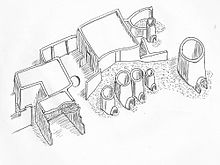
E. Christiana Köhler has shown that in late prehistoric Buto, mainly due to the unfavorable climatic conditions of the Nile Delta, a non-industrial ceramic production that corresponds to that of primary household production developed. At the same time, a specialization in production could already be identified in Upper Egypt in the late Naqada I and early Naqada II: The typical settlement ceramics are simple, heavily leaned and lightly fired Nile clay ( rough ware). The red goods typical of the cemeteries, the clay base of the red- polished and black-topped goods, were produced under completely different conditions: “While the coarse rough goods of the settlements are only approx. 500 to max. 800 ° C, temperatures of up to 1000 ° C are to be assumed for the fire of the red goods. ”In addition, the red goods have a fine, dense structure, are seldom thickened and require a controlled firing process. This situation suggests that two different productions already existed, namely professional, specialized production of cemetery ceramics and household production of rough goods.
The favorable ecological conditions appear to have been more conducive to specialized pottery production in Upper Egypt. In densely populated areas such as Hierakonpolis and Naqada there was also a great need for ceramics. “In the course of Naqada II, a society developed in Upper Egypt that attached great importance to their burials and the objects in them, so that the demand for high-quality ceramics could quickly increase.” Funeral ceramics in particular seem to have a need for one Having triggered specialization, since the fine goods are mainly to be found in cemeteries and less in the settlement context.
The best archaeological evidence for pottery production is provided by pottery ovens:
- Ceramic production in Hierakonpolis already assumed astonishing conditions in predynastic times. 15 furnace complexes could be detected. The unearthed ovens are technically not very sophisticated, but they produced at least three different types of goods in many different forms and supplied households and cemeteries.
- In the late 5th or early 6th dynasty, the Chentkaus II pyramid was made in Abusir in the mortuary temple . A small workshop was built, which dates a little later than the actual foundation. Inside the temple were the manufacturing facility, storage area, and furnace. Presumably, vessels were made for the cult activities.
- In Giza , near the mortuary temple of Mykerinos, an industrial area was excavated that also contained ovens. Mark Lehner also identified possible facilities for the feasting of clay. The whole food and ceramics production was done for the cult activities.
- At Elephantine , stoves were found outside the city's perimeter wall from the Old Kingdom . They date from the middle of the 4th to the 5th Dynasty and were possibly part of a larger industrial area.
- The best example of a workshop from the settlement context comes from Ayn Asil in the Dachla oasis. This produced ceramics from the end of the Old Kingdom to the First Intermediate Period and, like that of Elephantine, was located outside the enclosure wall. It is estimated that workers' teams of five to ten people worked in it. A wide range of clays were processed and shapes produced. The production of bread baking molds led the excavators to suspect that there was no household production, as these were most likely produced by the individual households. However, not all of the city's needs were met with this production and only a few of these types of ceramics were found in the city's cemeteries.
- A pottery workshop was discovered at Nag el-Baba in Nubia , dating back to the 12th Dynasty and the Second Intermediate Period. It was a system with several rooms, among other things for the preparation of the clay and with "simpler" ovens. Tools could also be identified, possibly including parts of pottery wheels.
- In the city of Amarna from the time of Akhenaten (New Kingdom), several stoves have been identified, both as part of an industrial production and a household production.
- One was found in Harube in North Sinai around the same time as the Amarna workshops . It was outside the settlement in an area with granaries and contained areas for clay preparation and ovens. It served to supply surrounding fortresses and official convoys that crossed the area.
Classification and analysis
In archeology, various methods have been developed as an auxiliary construction for recording and classifying goods. The most important is the so-called Viennese system. The following terms are used, among others:
- Basic mass : This describes the clay mixture, which consists of a combination of certain types of clay and lean substances / inclusions.
- Design: This also includes the changes to the mixture that the potter deliberately influenced, such as lean additives or surface treatment.
- Goods : This can be the generic term for several styles if they have the same mixture of tones.
- Product group: Several designs can be combined in one product group with the same basic dimensions and comparable properties.
- Fracture / fracture pattern: This describes the impression of the fresh fracture of a body made for assessment at a representative point.
The Vienna system
The “Viennese System” describes a classification system for Egyptian ceramics that the archaeologists and Egyptologists Dorothea Arnold, Manfred Bietak , Janine Bourriau , Helen and Jean Jacquet and Hans-Åke Nordström developed at a meeting in 1980 in Vienna . All of them brought shards from their excavations, which, with a few exceptions, formed the starting point for the classification. As a result, the Viennese system is mainly based on types of ceramics from the "classical" periods and regions of Egypt. According to the initiators, it should only be a starting point, instructions for describing goods. The distinction between different goods is based on a measurement of the size of organic and inorganic inclusions.
The inclusions are divided into three groups according to their size. Mineral particles such as sand and limestone come in fine (60–250 micrometers ), medium (250–500 micrometers) and coarse (larger than 500 micrometers), and straw in fine (smaller than two millimeters), medium (two to five millimeters) and coarse (larger than five millimeters).
The informative value of the system is limited by the arbitrariness of the potter and a certain randomness. In addition, different criteria are used to classify the Nile and marl clays: “Marl clays denote naturally occurring geological groups, while Nile clays evidently artificially created mixtures serve to differentiate.” In addition, the system does not take any surface treatment into account. The system can only be used to a limited extent for predynastic ceramics and ceramics after the New Kingdom. This shows the uncertain state of the (published) research and the large differences in technology, distribution and raw materials that occur in these two periods.
Nilton A
The basic mass consists of a homogeneous, fine clay and a significant proportion of clay. It contains fine sand as inclusions and a striking amount of medium-sized sand and occasionally coarse sand grains. Mica is also present. Small amounts of tiny straw particles can occur, but are very atypical for this design. The clay / loam ratio and the fine inclusions suggest that the sand is a natural component and was not added as a lean.
Nilton B
Nilton B is divided into B1 and B2:
- B1: The ground mass is relatively muddy and not as fine as with Nilton A. There are plenty of inclusions of fine sand, with scattered particles of medium coarse to coarse sand. Mica particles are common. Occasional fine straw particles (smaller than two millimeters) also appear. Often the surface and cut surface are uniformly red-brown, but black / gray or black / red zones can occur. This type of production is common from the Old Kingdom to the beginning of the 18th Dynasty. It is the raw material for the hemispherical bowls and "cups" from the Middle Kingdom and is particularly characteristic of the fine goods of the delta and the Memphis - Fayum region from this period.
- B2: The basic mass is similar to B1, but mineral and organic inclusions occur in larger sizes and quantities. Inclusions of fine sand are abundant and grains of medium size sand are common. Rounded sandstone grains can occur, along with limestone inclusions, some of which show signs of weathering. The distinction between the B and C matrixes is not always easy to draw, especially between B2 and C. A guide is that sand and not straw is the dominant inclusion in the B matrix. In contrast to B1, B2 is common in all periods and regions. For example, Dorothea Arnold identified four variants of it in Lischt -Süd. Manfred Bietak determined a coarse-grained variant for the Second Intermediate Period in Tell el-Dab'a . Other occurrences are, for example, in the late 12th and 13th dynasties in Dahshur and in the late 18th dynasty in Karnak .
Nilton C
This material is made up of muddy clay that contains irregularly shaped to rounded grains of sand that vary from fine to coarse and in frequency from rare to frequent. Inclusions of limestone and other minerals such as mica, crushed cullet and medium-sized stone particles can occur. Straw inclusions dominate and are visible in the cut and on the surface. They range from fine to coarse, with an excess of coarse particles (larger than five millimeters). The straw remains as charred particles, as white or gray silica skeletons and as impressions in the paste. Nilton C appears in all periods and regions and thus includes a wide range of variants.
Nilton D
The main feature of the Nile D is the noticeable proportion of limestone inclusions that appear either as natural additives or as deposits. Without this visible limestone content, this clay would be classified in various ways, as Nile clay A (from Tell el-Dab'a), as low-fired Nile clay B1 (from Dahshur) or as Nile clay B2 - Nile C (from Memphis).
Nilton E.
This clay consists of a large number of fine to coarse, rounded grains of sand that are clearly visible on the surface and cracks. Apart from these diagnostic inclusions, the structure can have properties of Nile B or Nile C. So far, Nilton E could only be determined geographically, in the eastern delta (Tell el-Dab'a and Qantir ) and in the region around Memphis to southern Fayum.
Marl clay A
This group was divided into four variants. The unifying characteristic of marl clay A is its compact and homogeneous base mass, which contains fine mineral inclusions and very few organic substances.
- Marl clay A1: The base mass is made up of a relatively fine and homogeneous clay, which has been made leaner with visible particles of fine to medium limestone. This is dominant in the fracture pattern and also visible on the surface. The particles are pointed and vary in size from 60 to 400 microns, with occasional larger particles. Fine sand and dark mica particles are common, but there are also few organic inclusions (straw). This tone was common from Naqada II to the Old Kingdom and is one of the styles of Meidum ware.
- Marl clay A2: In this variant, the mineral inclusions are much finer and evenly distributed through the paste. Fine sand and limestone particles are present, but none are dominant. Dark mica inclusions are present in small amounts. Marl clay A2 appears from the Middle Kingdom, but is found most frequently and more frequently in Upper than Lower Egypt in the late 2nd Intermediate Period and in the 18th Dynasty.
- Marl clay A3: This clay appears most similar to the modern Qena clay to the eye, although we cannot assume that it was mined in this region. Few mineral inclusions are visible under low magnification in the fracture image and there is no evidence that any were added to the material as leanings. The paste is exceptionally fine and homogeneous, which could be due to careful preparation of the clay, perhaps by additional grinding. Occasionally, straw particles can appear as random inclusions. This style appears from the early Middle Kingdom to the New Kingdom and seems to come from Upper Egypt. In contrast, it rarely appears in the eastern delta (Tell el-Dab'a and Qantir) and the Memphis Faiyum region.
- Marl clay A4: Of all the variants of marl clay A, this has the coarsest mixture and the largest quantity of fine to coarse sand inclusions. Isolated mica inclusions and sometimes straw particles can also be present. This sound already appears in the Middle Kingdom, but is most common in the New Kingdom (Amarna, Malqata, Memphis, Saqqara, etc.).
Marl clay B
The basic mass is homogeneous and very dense. The diagnostic quality of the design is that it contains a lot of sand, which makes up about 40 percent of the paste and was added as a lean. The particles range from angular to poorly rounded and fine to coarse. As with marl clay A4, limestone inclusions are visible at low magnification, but these appear as calcareous material in the clay matrix at 45 times magnification. Marl clay B was used exclusively for large and medium-sized vessels and seems to have occurred very limited in time and space: in the 2nd Intermediate Period and in the New Kingdom in Upper Egypt.
Marl clay C
This group is divided into three further variants. The consistent and diagnostic property is numerous limestone particles that are more or less decomposed and range from medium to coarse in size. This gives the style a speckled appearance. The base itself is fine and dense. Fine and medium-sized sand particles, added as lean, are also present, as well as light and dark mica portions.
- Marl clay C1: This variant is defined by the mass of fine to medium crushed limestone particles. The break is almost always made up of different zones, each red with a gray or black core, and sometimes shows signs of preliminary glazing.
- Marl shade C2: Many of the limestone particles remain intact and the fracture pattern is not zoned, but a uniform color ranging from red (Munsell 10R 4/6) to brown (Munsell 5YR 6/6). Another difference between C1 and C2 is the leaning of the sand: with C2, the proportion of sand is greater than the proportion of lime.
- Marl clay C compact: This clay contains much less sand than C1 and C2 and is much denser. This variant was previously only associated with one product, namely large, egg-shaped bottles with a grooved neck.
Marl clay D.
The base is fine and homogeneous. The characteristic are the limestone particles, which were probably added as a lean. They are smaller in size than those in marl clay C. They vary from fine to coarse and comprise about 25 percent of the base mass (and thus less than the limestone lean of marl clay C). Other lean components are sand (fine to coarse), black mica and dark stone. Organic inclusions are very rare. The surface feels noticeably sandy. This style was very common in the delta and in the Memphis-Fayum region from the 18th to the 19th dynasty and seems to only occur in the north as imports from the south.
Marl clay E.
The composition is similar to that of marl clay B, with the exception of visible medium to coarse straw particles that were added as lean. In addition, there are also sand inclusions (medium to coarse, 20–40 percent of the clay mass), mica particles and particles of unmixed base material. This design is relatively rare, but was found in Memphis and Upper Egypt (Koptos and Deir el-Ballas) during the short period from the 2nd Intermediate Period to the early 18th Dynasty. It was mainly used for thick-walled vessels, often hand-shaped bread trays. This suggests that the intended addition of straw is related to this particular function.
Make code
E. Christiana Köheler developed a design code for the early ceramics from Buto and Helwan , which can only be reconciled to a limited extent with the Viennese system. This five-digit number code is made up of different criteria, whereby the position of a number within the number code indicates a criterion: appearance (coarse / heavy, medium and fine with the digits 1–3), key (nile tone = 1, marl tone = 2, other tone = 3), surface design (broom stroke roughening = 1, rough-smoothed = 2, well-smoothed = 3 and polished = 4), coating (no coating = 0, white coating = 2, red = 3, other color = 4) and the presence of Inclusions or emaciation (normal = 1, predominantly chaff = 2, predominantly sand = 3, a lot of lime = 4, very little or none = 5, fibers = 6).
Petrographic analysis
Petrographic analysis has proven useful as a complementary system for classification and analysis based on features visible to the eye or microscope . This technique examines thin sections of the ceramic or extracted mineral inclusions, which can provide further insight:
- Many mineral and organic inclusions can be identified.
- The structure and porosity can be determined more precisely.
- The original firing temperature can be determined.
- The origin of the clay can be determined.
- It can be decided whether inclusions occur naturally or whether they have been added as lean.
Chemical and mineralogical analyzes
As in the rest of archeology, chemical and mineralogical methods are also used to determine the composition of the clay. This includes:
- Neutron Activation Analysis (NAA)
- Instrumental Neutron Activation Analysis (INAA)
- X-ray fluorescence analysis (XRF) (English X-ray fluorescence spectroscopy , XRF spectroscopy )
- Atomic emission spectrometry (AES), often also called optical emission spectrometry (OES)
- Atomic Absorption Spectrometry (AAS)
- Mass spectrometry with inductively coupled plasma (ICP-MS)
- X-ray diffraction (international X-Ray Diffraction , XRD)
Ceramic dating (using the example of the Naqada culture)

In the archaeological and relative chronology , the method of the ceramic has Seriation been useful. This method was invented by WM Flinders Petrie in 1899 . In the late 20th century there was a tremendous increase in the study of Egyptian ceramics, both in terms of the amount of sherds that are analyzed (from a variety of different archaeological sites) and in the range of scientific techniques that have been used since then, to gain more information from ceramics. So one began to classify the changes in the types of vessels over time more and more precisely. For example, the shape of bread baking molds was subject to major changes at the end of the Old Kingdom. However, it is not yet entirely clear whether these processes have social, economic and technological causes or whether they are just a “fad”. Seen in this light, there have been many reasons for the changes in material culture and only some can be linked to the political changes that dominate conventional views of Egyptian history.
Nevertheless, connections can be made, for example, between the political and cultural change and centralized production of ceramics in the Old Kingdom and the resurgence of local types of pottery during the politically decentralized First Intermediate Period and a renewed unification during the reunified 12th Dynasty. By studying ceramics, other artifacts, environmental factors and agricultural changes, the basis can be created for a holistic view of Egyptian history, in which political developments are seen in the context of a long process of cultural change.
Petries Sequence Dating

WM Flinders Petrie was the first to attempt a ceramic seriation (his so-called sequence dating ) using ceramics from the Naqada culture . He published the first study on the relative chronology of the Naqada culture in 1899. His first "predynastic" corpus is based on the grave goods from the cemeteries of Naqada , Ballas and Diospolis Parva . Originally he distinguished between nine classes and over 700 types of ceramics. For the classification he selected 900 intact graves of five or more types from the more than 4000 excavated graves. To do this, he created index cards and tried to organize them. He made two main observations:
- White cross-lined ceramics on the one hand and decorated and wavy-handled ceramics on the other hand practically never came together.
- The development of the shape of the Wavy-Handled types ranges from spherical to cylindrical and from functional handles to decorative lines.
After Petrie had sorted all the index cards, he divided them into 50 groups, each of which contained 18 graves. He defined SD 30 as a starting point in order to leave room for possible earlier cultures that had not yet been discovered. He further divided the 50 sequence dates into three groups, which he classified as archaeologically, culturally and chronologically different, and named them after important sites: Amratian (SD 30–37), Gerzean (SD 38–60) and Semainean (SD 60– 75).
Petrie created a second corpus for the protodynastic ceramic based on the findings in the Tarchan cemetery . Here he distinguished 885 types, but no classes, which makes it difficult to use. This partially overlaps with the predynastic corpus. It starts with SD 76 and goes up to SD 86, whereby SD 83-86 remain fairly theoretical due to the lack of material from the 2nd dynasty. This time the transition to new sequence dates was based mainly on typological breaks, which Petrie defined on the basis of the development of the Wavy-Handled types. He also linked the Sequence Dates with the historically dated ceramic types and other objects in the royal tombs of the early dynasties in Abydos.
Some methodological problems arose in Petrie's classification:
- There is no distinction between typology and chronology.
- The classes are defined very heterogeneously.
- The definitions are not bound by strict rules.
- Only graves with five or more objects were used, which means that the early periods are underrepresented.
- Regional differences were not taken into account.
- The horizontal distribution of the ceramics within a cemetery was not considered as a further criterion.
- A systematic problem with sequence dates is that - when new graves are added - new types have to be defined.
- Typology of Wavy Handled ceramics according to Petrie
Emperor's step chronology
The first to re-examine the relative chronology of the predynastic period was Werner Kaiser . He largely accepted Petrie's typology. The cemetery 1400–1500 in Armant served as a starting point for Kaiser . In addition, Kaiser also used the horizontal distribution of the pottery, and if a period in Armant was not documented, the pottery from other cemeteries as well. He distinguished three spatial zones within the cemetery according to their relative frequency, each of which was dominated by a specific group: Black-Topped , Rough Wares and Late , as well as Wavy Handled Wares . Within these periods he made subdivisions which he called stages. In total, he identified eleven stages. These do not entirely, but largely agree, with Petrie's classification.
According to Kaiser, the following main levels result:
- Level I: This level covers all sites in Upper Egypt, from the Badarian regions to south of Aswan . The cemeteries are dominated by the black-topped ceramic, which makes up more than 50 percent of the ceramic. The second most important types are red-polished and white-cross-linded ceramic.
- Stage II: According to Werner Kaiser’s definition, this stage should be dominated by the rough ceramic. However, in level IIa, the black-topped still dominated - over the rough ceramic. With the transition from level IIb to IIc, the Wavy-Handled ceramic was introduced. In addition, some new decorated types were added.
- Stage III: In this stage the late ceramic is numerically predominant over the rough . However, it must be taken into account that a large number of the late types were manufactured in the same way as the rough goods. This stage is particularly important for the relative chronology of the predynastic time and the early period, as it contains the final phase of state formation and can be partially linked to the historical chronology of the 1st and 2nd dynasties.
There were also some problems with this chronology:
- Almost only one cemetery was used, which makes regional differentiation impossible.
- Levels Ia, Ib and IIIb are rather hypothetical, especially the development of the Wavy-Handled class.
- Kaiser published only an abbreviated version as an article in which only the characteristic types for each level are shown.
Stan Hendrickx
Since the mid-1980s, Stan Hendrickx continued and improved Werner Kaiser's model. He proceeds according to the same principle by differentiating groups of graves that belong together (i.e. taking into account the spatial distribution within a cemetery) and not only differentiating the graves on the basis of their content. This results in a conflict of interest between the search for a narrower chronological arrangement for all ceramic types on the one hand and the definition of spatially well-defined groups on the other. Neither of these two criteria can be accepted as predominating over the other.
Computer seriation
BJ Kemp made a multi-dimensional scaling of the graves in cemetery B in el-Amrah and in the cemetery of el-Mahasna. However, this seriation was not used to evaluate Kaiser’s step chronology, but only to Petries Sequence Dating .
TAH Wilkinson carried out a seriation of eight pre- and early dynastic cemeteries on the basis of 1420 (out of a total of 1542) types from Petrie's corpus, which were combined into 141 groups. There were major problems with the newly defined groups, as they are defined very heterogeneously. For example, the cylindrical vessels with incised decorations and without were put in the same group, which according to Kaiser was an important chronological indicator.
literature
- RO Allen, H. Hamroush, MA Hoffman: Archaeological implications of differences in the composition of Nile sediments. In: Ralph O Allen: Archaeological Chemistry IV: developed from a symposium sponsored by the Division of History of Chemistry at the 193rd meeting of the American Chemical Society, Denver, Colorado, April 5-10, 1987. American Chemical Society, Washington 1989, ISBN 978-0-8412-1449-1 , pp. 33-56.
- Dorothea Arnold : Article ceramics. In: Wolfgang Helck , Wolfhart Westendorf: Lexicon of Egyptology. (LÄ) Volume III: Horhekenu - Megeb. Harrassowitz, Wiesbaden 1980, ISBN 978-3-447-02100-5 , Sp. 392-409.
- Dorothea Arnold, Janine Bourriau (eds.): An Introduction to Ancient Egyptian Pottery (= German Archaeological Institute, Cairo Department. [DAIKS] special publication 17). von Zabern, Mainz 1993.
- Dorothea Arnold: Studies on ancient Egyptian ceramics (= DAIKS. Special writings 9). von Zabern, Mainz 1981.
- Dorothea Arnold: mural and fragment findings. On the pottery technique of the ancient Egyptians from the beginning of the Pharaonic times to the Hyksos. In: Communications from the German Archaeological Institute, Cairo Department. (MDAIK) Vol. 32, 1976, pp. 1-34.
- Dean E. Arnold: Ceramic Theory and Cultural Process (= New studies in archeology. ). Cambridge University Press, New York 1985, ISBN 978-0-521-25262-1 .
- Janine D. Bourriau , Paul T. Nicholson , Pamela J. Rose: Pottery. In: Paul T. Nicholson, Ian Shaw (Eds.): Ancient Egyptian Materials and Technology. Cambridge University Press, Cambridge / New York 2000, ISBN 978-0-521-45257-1 , pp. 121-147.
- Colin A. Hope: Egyptian Pottery (= Shire Egyptology. Vol. 5). Shire, Aylesbury 1987, ISBN 978-0-85263-852-1 .
- E. Christiana Köhler : Buto III. Ceramics from late prehistory to the early Old Kingdom (layers III to VI) (= archaeological publications of the German Archaeological Institute in Cairo. Vol. 94). von Zabern, Mainz 1998.
- Christina Regner: Ceramics (= Bonn collection of Aegyptiaca. Vol. 3). Harrassowitz, Wiesbaden 1998, ISBN 978-3-447-04114-0 . ( Online )
- Robert Schiestl, Anne Seiler: Handbook of Pottery of the Egyptian Middle Kingdom. Volume I: The Corpus Volume. Volume II: The Regional Volume. Publishing house of the Austrian Academy of Sciences, Vienna 2012.
- Anna Wodzińska: A Manual of Egyptian Pottery (= AERA field manual series. ). Ancient Egypt Research Associates (AERA), Boston, 2009/2010:
- Volume 1: Fayum A - Lower Egyptian Culture (= AERA field manual series. Vol. 1). 2009, ISBN 978-0-9779370-2-8 .
- Volume 2: Naqada III - Middle Kingdom (= AERA field manual series. Vol. 1). 2009, ISBN 978-0-9825544-5-6 .
- Volume 3: Second Intermediate Period - Late Period (= AERA field manual series. Vol. 1). 2010, ISBN 978-0-9825544-0-1 .
- Volume 4: Ptolemaic Period - Modern (= AERA field manual series. Vol. 1). 2010, ISBN 978-0-9825544-2-5 .
Web links
- reshafim.org: Pottery.
- Digital Egypt for Universities: Pottery in Egypt ( Memento from April 26, 2006 in the Internet Archive )
Individual evidence
- ↑ a b Dorothea Arnold: Article ceramic. In: Wolfgang Helck, Wolfhart Westendorf: Lexicon of Egyptology. Volume III, Wiesbaden 1980, Col. 392
- ^ A b D. Arnold: Ceramics. In: LÄ III , Sp. 394.
- ↑ C. Regner: Keramik (= Bonn collection of Aegyptiaca. Vol. 3). Wiesbaden 1998, p. 5.
- ^ A b Janine D. Bourriau, Paul T. Nicholson, Pamela J. Rose: Pottery. In: Paul T. Nicholson, Ian Shaw (Eds.): Ancient Egyptian Materials and Technology. Cambridge 2000, p. 121.
- ↑ C. Regner: Keramik (= Bonn collection of Aegyptiaca. Vol. 3). Wiesbaden 1998, p. 10 f.
- ^ D. Arnold: Ceramics. In: LÄ III , Sp. 395.
- ↑ Janine D. Bourriau, Paul T. Nicholson, Pamela J. Rose: Pottery. In: Paul T. Nicholson, Ian Shaw (Eds.): Ancient Egyptian Materials and Technology. Cambridge 2000, p. 122.
- ↑ a b c d e f D. Arnold: Ceramic. In: LÄ III , Sp. 399.
- ^ D. Arnold, J. Bourriau: An Introduction to Ancient Egyptian Pottery. Mainz 1993, p. 11 f.
- ^ D. Arnold, J. Bourriau: An Introduction to Ancient Egyptian Pottery. Mainz 1993, p. 12.
- ↑ G. Soukiassian, M. Wuttmann, L. Pantalacci, P. Ballet, M. Picon: Balat III. Les Ateliers de Potiers d'Ayn-Asil. Cairo 1990, p. 43.
- ^ RO Allen, H. Hamroush, MA Hoffman: Archaeological implications of differences in the composition of Nile sediments. (= Archaeological Chemistry. Vol. IV) Washington 1989, p. 55.
- ^ D. Arnold: Ceramics. In: LÄ III , col. 400; D. Arnold, J. Bourriau: An Introduction to Ancient Egyptian Pottery. Mainz 1993, p. 12 f .; Janine D. Bourriau, Paul T. Nicholson, Pamela J. Rose: Pottery. In: Paul T. Nicholson, Ian Shaw (Eds.): Ancient Egyptian Materials and Technology. Cambridge 2000, p. 122; E. Christiana Köhler: Buto III. Ceramics from late prehistory to the early Old Kingdom (layers III to VI). Mainz 1998, p. 68; D. Arnold: mural and fragment findings. On the pottery technique of the ancient Egyptians from the beginning of the Pharaonic times to the Hyksos. 1976, p. 3.
- ↑ C. Köhler: Buto III. Ceramics from late prehistory to the early Old Kingdom (layers III to VI). Mainz 1998, p. 68. Also: OS Rye: Keeping your temper under control: materials and the manufacture of Papuan pottery. In: Archeology and Physical Anthropology in Oceania. Vol. II, No. 2, 1976, pp. 106-137.
- ^ D. Arnold: Ceramics. In: LÄ III , col. 400; D. Arnold, J. Bourriau: An Introduction to Ancient Egyptian Pottery. Mainz 1993, p. 13 f.
- ↑ C. Köhler: Buto III. Ceramics from late prehistory to the early Old Kingdom (layers III to VI). Mainz 1998, p. 69.
- ↑ a b c d e f g C. Köhler: Buto III. Ceramics from late prehistory to the early Old Kingdom (layers III to VI). Mainz 1998, p. 69.
- ^ D. Arnold: Ceramics. In: LÄ III , Col. 401 f.
- ^ Susan Peterson, Bernd Pfannkuche, Alexandra Merz: Craft and art of ceramics. Technology, design, materials and history. Koönemann, Cologne 1999, ISBN 978-3-8290-2140-1 , p. 37.
- ^ S. Peterson, B. Pfannkuche, A. Merz: Handwerk und Kunst der Keramik .... Cologne 1999, p. 34.
- ^ D. Arnold: Ceramics. In: LÄ III , Sp. 403.
- ↑ a b c d C. Köhler: Buto III. Ceramics from late prehistory to the early Old Kingdom (layers III to VI). Mainz 1998, p. 70.
- ^ D. Arnold: Ceramics. In: LÄ III , Col. 403; Arnold: mural and fragment findings. P. 17; D. Arnold, J. Bourriau: An Introduction to Ancient Egyptian Pottery. Mainz 1993, p. 43 f.
- ↑ C. Köhler: Buto III. Ceramics from late prehistory to the early Old Kingdom (layers III to VI). Mainz 1998, p. 70 Note 390 with reference to DA Sürenhagen: Ceramic production in Ḥabūba Kabira. Hessling, Berlin 1978, p. 89 ff.
- ^ D. Arnold, J. Bourriau: An Introduction to Ancient Egyptian Pottery. Mainz 1993, p. 75 ff.
- ↑ a b c d e C. Köhler: Buto III. Ceramics from late prehistory to the early Old Kingdom (layers III to VI). Mainz 1998, p. 71.
- ^ D. Arnold: Ceramics. In: LÄ III , Col. 401 f.
- ^ D. Arnold: Ceramics. In: LÄ III , Col. 404 f.
- ^ D. Arnold, J. Bourriau: An Introduction to Ancient Egyptian Pottery. Mainz 1993, p. 84.
- ↑ C. Köhler: Buto III. Ceramics from late prehistory to the early Old Kingdom (layers III to VI). Mainz 1998, p. 68.
- ^ A b Janine D. Bourriau, Paul T. Nicholson, Pamela J. Rose: Pottery. In: Paul T. Nicholson, Ian Shaw (Eds.): Ancient Egyptian Materials and Technology. Cambridge 2000, p. 127.
- ↑ a b c C. Köhler: Buto III. Ceramics from late prehistory to the early Old Kingdom (layers III to VI). Mainz 1998, p. 72.
- ↑ Janine D. Bourriau, Paul T. Nicholson, Pamela J. Rose: Pottery. In: Paul T. Nicholson, Ian Shaw (Eds.): Ancient Egyptian Materials and Technology. Cambridge 2000, p. 128.
- ^ WM Flinders Petrie , James Edward Quibell: Naqada and Ballas. 1895. Quaritch, London 1896, p. 37 ( online ).
- ^ D. Arnold, J. Bourriau: An Introduction to Ancient Egyptian Pottery. Mainz 1993, p. 88 f.
- ^ D. Arnold, J. Bourriau: An Introduction to Ancient Egyptian Pottery. Mainz 1993, p. 89 ff.
- ^ D. Arnold, J. Bourriau: An Introduction to Ancient Egyptian Pottery. Mainz 1993, p. 94 f .; Alfred Lucas: Ancient Egyptian Materials and Industries. London, 1962 (3rd ed.), Pp. 61-98.
- ^ D. Arnold, J. Bourriau: An Introduction to Ancient Egyptian Pottery. Mainz 1993, p. 95 ff.
- ^ A b Janine D. Bourriau, Paul T. Nicholson, Pamela J. Rose: Pottery. In: Paul T. Nicholson, Ian Shaw (Eds.): Ancient Egyptian Materials and Technology. Cambridge 2000, p. 142.
- ↑ a b C. Köhler: Buto III. Ceramics from late prehistory to the early Old Kingdom (layers III to VI). Mainz 1998, p. 40 ff.
- ^ Leonhard H. Lesko: Egyptian Wine Production During the New Kingdom. In: The Origins and Ancient History of Wine. Amsterdam, 1997, p. 221 f. and Leonhard H. Lesko: King Tut's Wine Cellar. Berkley, 1977, p. 49.
- ↑ Janine D. Bourriau, Paul T. Nicholson, Pamela J. Rose: Pottery. In: Paul T. Nicholson, Ian Shaw (Eds.): Ancient Egyptian Materials and Technology. Cambridge 2000, p. 143.
- ↑ Janine D. Bourriau, Paul T. Nicholson, Pamela J. Rose: Pottery. In: Paul T. Nicholson, Ian Shaw (Eds.): Ancient Egyptian Materials and Technology. Cambridge 2000, pp. 135 ff .; C. Eyre: Work and Organization of Work in the Old Kingdom. In: MA Powell (Ed.): Labor in the Ancient Near East. (= American Oriental Studies 68) New Haven, 1987 (pp. 5-48), pp. 27, 30; C. Eyre: Work and Organization of Work in the New Kingdom. In: MA Powell (Ed.): Labor in the Ancient Near East. (= American Oriental Studies 68) New Haven, 1987 (pp. 167-222), p. 193; R. Holthoer: New Kingdom Pharaonic Sites: The Pottery. Stockholm, 1977; Colin Hope: Ancient Pottery. Aylesbury, 1987, pp. 7-9; Barry J. Kemp: Amarna Reports V. London, 1989, pp. 56-63.
- ↑ Janine D. Bourriau, Paul T. Nicholson, Pamela J. Rose: Pottery. In: Paul T. Nicholson, Ian Shaw (Eds.): Ancient Egyptian Materials and Technology. Cambridge 2000, pp. 135 f.
- ^ A b Janine D. Bourriau, Paul T. Nicholson, Pamela J. Rose: Pottery. In: Paul T. Nicholson, Ian Shaw (Eds.): Ancient Egyptian Materials and Technology. Cambridge 2000, p. 136.
- ^ Günter Burkard, Heinz J. Thissen: Introduction to the ancient Egyptian literary history. I. Old and Middle Kingdom. Münster, 2008, p. 174. See also Stephan Jäger: Ancient Egyptian occupational typologies. Göttingen, 2004.
- ^ Dorothea Arnold et al .: Masterpieces of ancient Egyptian ceramics. 5000 years of art and handicrafts made from clay and faience: [Exhibition] Höhr-Grenzhausen, Rastal-Haus, September 16 to November 30, 1978. Westerwald Support Group for Art and Ceramics, Montabaur 1978, ISBN 978-3-921548-06-6 , P. 24.
- ^ D. Arnold et al .: Masterpieces of ancient Egyptian ceramics. ... Montabaur 1978, p. 27.
- ^ Stephan Johannes Seidlmayer: Between state economy and mass consumption. On technology and economy in Egypt from the Old to the Middle Kingdom. Article at the Free University of Berlin on April 18, 2012 ( full text as PDF file, online ).
- ↑ Stephan Johannes Seidlmayer: Grave fields from the transition from the Old to the Middle Kingdom. Studies in the Archeology of the First Intermediate Period. (= Studies in Archeology and History. Vol. 1). Heidelberger Orientverlag, Heidelberg 1990, ISBN 978-3-927552-01-2 .
- ↑ C. Köhler: Buto III. Ceramics from late prehistory to the early Old Kingdom (layers III to VI). Mainz 1998, p. 75 f.
- ↑ C. Köhler: Buto III. Ceramics from late prehistory to the early Old Kingdom (layers III to VI). Mainz 1998, p. 77.
- ↑ Janine D. Bourriau, Paul T. Nicholson, Pamela J. Rose: Pottery. In: Paul T. Nicholson, Ian Shaw (Eds.): Ancient Egyptian Materials and Technology. Cambridge 2000, p. 137 ff. The list does not claim to be exhaustive and only mentions clearly identifiable objects.
- ↑ Michael A Hoffman et al .: The Predynastic of Hierakonpolis: an Interim Report (= Publication [Egyptian Studies Association] No. 1). Cairo University Herbarium, Faculty of Science, Giza 1982 / Western Illinois University, Macomb Ill 1982, ISBN 978-977-721-653-1 ; Masahiro Baba: Pottery production at Hierakonpolis during the Naqada II period: Toward a reconstruction of the firing technique. In: British Museum Studies in Ancient Egypt and Sudan. No. 13, 2009, pp. 1–23 ( online ; PDF; 9.8 MB).
- ↑ Miroslav Verner: Discovery of a potter's workshop in the pyramid complex of Khentkaus at Abusir. In: Cahiers de la Céramique Égyptienne. (CCE) Vol. 3, 1992, pp. 55-60.
- ↑ Mark Lehner: Giza. A contextual approach to the Pyramids. In: Archive for Orient Research. No. 32, 1985 (pp. 136-158), p. 157.
- ^ W. Kaiser, R. Avila, G. Dreyer, H. Jaritz, F. Seidelmayer, S. Seidelmeyer: City and Temple of Elephantine. In: Communications from the German Archaeological Institute, Cairo Department. No. 38, 1982 (pp. 271-345), pp. 296 ff.
- ↑ G. Soukiassian, M. Wuttmann, L. Pantalacci, P. Ballet, M. Picon: Balat III. Les Ateliers de Potiers d'Ayn-Asil. Cairo 1990; A. Minault-Gout, P. Deleuze: La mastaba d'Ima-Pépi. Cairo 1992.
- ↑ R. Holthoer: New Kingdom sites: The Pottery. Stockholm 1977, pp. 16-17; T. Säve-Söderbergh: Middle Nubian Sites. Partille 1989, pp. 16-17.
- ^ PT Nicholson: Report on the 1987 excavations: the pottery kilns in building Q48.4. In: Barry Kemp (Ed.): Amarna Reports. Volume V, London 1989, pp. 64-81; Pamela Rose: Report on the 1987 excavations: The evidence for potterymaking at Q48.4 In: Barry Kemp (Ed.): Amarna Reports V, London 1989, pp. 82-101; C. Powell: The nature and use of ancient Egyptian potter's wheel. In: BJ Kemp (ed.): Amarna Reports. Volume VI, London 1995, pp. 309-335.
- ↑ ED Oren: The 'Ways of Horus' in North Sinai. In: AF Rainey (ed.): Egypt, Israel, Sinai. Archaeological And Historical Relationships In The Biblical Period. Tel Aviv 1987, pp. 97-106.
- ↑ C. Köhler: Buto III. Ceramics from late prehistory to the early Old Kingdom (layers III to VI). Mainz 1998, p. 5.
- ^ Hans-Åke Nordström, Janine Bourriau: Ceramic Technology: Clays and Fabrics. In: Dorothea Arnold, Janine Bourriau: An Introduction to Ancient Egyptian Pottery. Fascicle 2 (= German Archaeological Institute, Cairo Department. Special publication 17). von Zabern, Mainz 1993, pp. 168-182; Hans-Åke Nordström: Article Ton. In: Wolfgang Helck, Wolfhart Westendorf: Lexicon of Egyptology. Volume VI, Wiesbaden 1986, Sp. 629-634; Janine D. Bourriau, Paul T. Nicholson, Pamela J. Rose: Pottery. In: Paul T. Nicholson, Ian Shaw (Eds.): Ancient Egyptian Materials and Technology. Cambridge 2000, pp. 130-132.
- ↑ H.-Å. Nordström, J. Bourriau: Ceramic Technology: Clays and Fabrics. Mainz 1993, p. 169.
- ↑ C. Köhler: Buto III. Ceramics from late prehistory to the early Old Kingdom (layers III to VI). Mainz 1998, p. 13 f.
- ↑ Janine D. Bourriau, Paul T. Nicholson, Pamela J. Rose: Pottery. In: Paul T. Nicholson, Ian Shaw (Eds.): Ancient Egyptian Materials and Technology. Cambridge 2000, p. 130.
- ↑ H.-Å. Nordström, J. Bourriau: Ceramic Technology: Clays and Fabrics. Mainz 1993, p. 170 f.
- ↑ H.-Å. Nordström, J. Bourriau: Ceramic Technology: Clays and Fabrics. Mainz 1993, p. 171.
- ↑ H.-Å. Nordström, J. Bourriau: Ceramic Technology: Clays and Fabrics. Mainz 1993, p. 171 f.
- ↑ H.-Å. Nordström, J. Bourriau: Ceramic Technology: Clays and Fabrics. Mainz 1993, p. 173 f.
- ↑ H.-Å. Nordström, J. Bourriau: Ceramic Technology: Clays and Fabrics. Mainz 1993, p. 174 f.
- ↑ H.-Å. Nordström, J. Bourriau: Ceramic Technology: Clays and Fabrics. Mainz 1993, p. 175.
- ↑ H.-Å. Nordström, J. Bourriau: Ceramic Technology: Clays and Fabrics. Mainz 1993, p. 176.
- ↑ H.-Å. Nordström, J. Bourriau: Ceramic Technology: Clays and Fabrics. Mainz 1993, p. 176.
- ↑ H.-Å. Nordström, J. Bourriau: Ceramic Technology: Clays and Fabrics. Mainz 1993, p. 177.
- ↑ H.-Å. Nordström, J. Bourriau: Ceramic Technology: Clays and Fabrics. Mainz 1993, p. 177 f.
- ↑ H.-Å. Nordström, J. Bourriau: Ceramic Technology: Clays and Fabrics. Mainz 1993, p. 178 f.
- ↑ H.-Å. Nordström, J. Bourriau: Ceramic Technology: Clays and Fabrics. Mainz 1993, p. 179 f.
- ↑ H.-Å. Nordström, J. Bourriau: Ceramic Technology: Clays and Fabrics. Mainz 1993, p. 180.
- ↑ H.-Å. Nordström, J. Bourriau: Ceramic Technology: Clays and Fabrics. Mainz 1993, p. 181.
- ↑ H.-Å. Nordström, J. Bourriau: Ceramic Technology: Clays and Fabrics. Mainz 1993, p. 181 f.
- ↑ H.-Å. Nordström, J. Bourriau: Ceramic Technology: Clays and Fabrics. Mainz 1993, p. 182.
- ↑ C. Köhler: Buto III. Ceramics from late prehistory to the early Old Kingdom (layers III to VI). Mainz 1998, p. 3 f.
- ↑ N. Porat, J. Seeher: Petrographic analyzes of pottery and basalt from Predynastic Maadi. In: Communications of the German Archaeological Institute, Cairo Department (MDAIK) No. 44, 1988, pp. 215–228; H. Hamroush, HA Zeid: Petrological and chemical analyzes of some neolithic ceramics from el Omari, Egypt. In: F. Debono, B. Mortensen (eds.): El Omari. Mainz 1990, pp. 117-128; P. Nicholson, P. Rose: Pottery fabrics and ware groups at el-Amarna. In: B. Kemp (Ed.): Amarna Reports II. London 1985, pp. 133-174; NRJ Filler, PT Nicholson: Grain size analysis of archaeological pottery: the use of statistical models. In: A. Middleton, I. Freestone (Ed.): Recent Developments in Ceramic Petrology. London 1991, pp. 71-111; K. Kroeper: Shape + Matrix = workshop. Ceramic from Minshat Abu Omar. In: Cahiers de la Céramique Égyptienne (CCE) No. 3, 1992, pp. 23-1; J. Riederer: The microscopic analysis of calcite tempered pottery from Minshat Abu Omar. In: Cahiers de la Céramique Égyptienne (CCE) No. 3, 1992, pp. 33-37; CA Redmount, ME Morgenstein: Major and trace element analysis of modern Egyptian pottery. In: Journal of Archaeological Science (JAS) No. 23, 1996, pp. 741-762.
- ↑ Janine D. Bourriau, Paul T. Nicholson, Pamela J. Rose: Pottery. In: Paul T. Nicholson, Ian Shaw (Eds.): Ancient Egyptian Materials and Technology. Cambridge 2000, p. 132 f.
- ↑ Janine D. Bourriau, Paul T. Nicholson, Pamela J. Rose: Pottery. In: Paul T. Nicholson, Ian Shaw (Eds.): Ancient Egyptian Materials and Technology. Cambridge 2000, p. 133 ff. With reference to further literature
- ^ Ian Shaw: Introduction: Chronologies and Cultural Change in Egypt. In: Ian Shaw: The Oxford History of Ancient Egypt. Oxford 2002, p. 13 f.
- ↑ WM Flinders Petrie: Sequences in Prehistoric Remains. In: Journal of the Royal Anthropological Institute (JRAI) No. 29, 1899, pp. 295–301 ( Online ( Memento of December 12, 2013 in the Internet Archive ); PDF; 1.5 MB).
- ^ WM Flinders Petrie, JE Quibell: Naqada and Ballas. 1895. London 1896.
- ^ WM Flinders Petrie, Arthur Cruttenden Mace: Diospolis Parva, the cemeteries of Abadiyeh and Hu, 1898-9 (= Memoir. Egypt Exploration Fund). London / Boston Mass 1901 ( online ).
- ^ WM Flinders Petrie: Corpus of Prehistoric Pottery and Palettes (= Publications of the British School of Archeology in Egypt. ). British school of Archeology in Egypt, London 1921 ( Online ( Memento from March 3, 2016 in the Internet Archive ); PDF; 3.0 MB).
- ↑ Stan Hendrickx: Predynastic - Early Dynastic Chronology. In: Erik Hornung, Rolf Krauss, David A. Warburton (eds.): Ancient Egyptian Chronology. Brill, Leiden / Boston 2006, ISBN 978-90-474-0400-2 , p. 60 ff.
- ^ WM Flinders Petrie: Corpus of Proto-Dynastic Pottery (= Publications of the British School of Archeology in Egypt. Vol. 66). British School of Archeology in Egypt, London 1953.
- ^ WM Flinders Petrie: Tarkhan I and Memphis V. (= Publications of the British School of Archeology in Egypt. Vol. 23). British School of Archeology in Egypt, London 1913 ( online ).
- ↑ Hendrickx: Predynastic - Early Dynastic Chronology. In: Ancient Egyptian Chronology. Leiden / Boston 2006, p. 62 f.
- ↑ Hendrickx: Predynastic - Early Dynastic Chronology. In: Ancient Egyptian Chronology. Leiden / Boston 2006, p. 63; Stan Hendrickx: The Relative Chronology of the Naqada Culture. Problems and Possibilities. In: Jeffrey Spencer: Aspects of Early Egypt. British Museum Press, London 1996, ISBN 978-0-7141-0999-2 , p. 38.
- ^ RL Mond, OH Myers: Cemeteries of Armant I. London 1937.
- ↑ Werner Kaiser: On the internal chronology of the Naqada culture. In: Archaeologia Geographica No. 6, 1957, pp. 69-77.
- ↑ Hendrickx: Predynastic - Early Dynastic Chronology. In: Ancient Egyptian Chronology. Leiden / Boston 2006, p. 71 ff.
- ↑ Hendrickx: Predynastic - Early Dynastic Chronology. In: Ancient Egyptian Chronology. Leiden / Boston 2006, p. 75 ff.
- ↑ Hendrickx: Predynastic - Early Dynastic Chronology. In: Ancient Egyptian Chronology. Leiden / Boston 2006, p. 81 ff.
- ↑ S. Hendrickx: Predynastic - Early Dynastic Chronology. In: Ancient Egyptian Chronology. Leiden / Boston 2006, p. 64 ff .; S. Hendrickx: The Relative Chronology of the Naqada Culture. In: Aspects of Early Egypt. London 1996, p. 38 ff.
- ↑ S. Hendrickx: Predynastic - Early Dynastic Chronology. In: Ancient Egyptian Chronology. Leiden / Boston 2006, pp. 55-93 .; S. Hendrickx: The Relative Chronology of the Naqada Culture. In: Aspects of Early Egypt. London 1996, pp. 36-69.
- ^ BJ Kemp: Automatic Analysis of Predynastic Cemeteries: A New Method for an Old Problem. In: Journal of Egyptian Archeology. No. 68, 1982, pp. 5-15.
- ^ TAH Wilkinson: A New Comparative Chronology for the Predynastic - Early Dynastic Transition. In: Journal of the Ancient Chronology Forum. (JACF) 7, 1994-1995, pp. 5-26.
Remarks
- ↑ The White Cross-lined ceramic consists mostly of sand gemagertem Nilton. The color of the surface ranges from dark red to reddish brown and has a polish. A characteristic feature is the white to cream-colored painting (predominantly geometric patterns, but also animals, plants, people and boats).
- ↑ The Decorated ceramic consists mostly of sand gemagertem marl clay. The surface is well smoothed but not polished. The color ranges from light red to yellowish gray. A painting was applied to the surface with red-brown paint. Main motifs are ships, desert game, flamingos, people, spirals, wavy lines and Z-lines.
- ↑ The Wavy-Handled ceramic occurs from the Naqada IIc-time appearance. In terms of texture and processing, it is identical to the decorated goods. The surface color ranges from light red to yellowish gray. The wave handle is characteristic.
- ↑ The black-topped ceramic consisting of sand-leaned Nile clay is typical for Naqada I and IIa-b. The main characteristic is the black border on dark red to reddish brown ceramic. The surface is almost always polished.
- ↑ The red polished ceramic is identical to the black topped ceramic, except that the black border is missing.
- ↑ The Rough ceramic consists of nile clay, which is heavily thickened with straw. The outsides are only roughly smoothed, with a red-brown surface, without polishing.
- ↑ The material of the late ceramic is the same as that of the decorated and wavy-handled goods and comprises different types of goods that only appeared in the late Naqada period. In addition, it is partly indistinguishable from rough goods.
